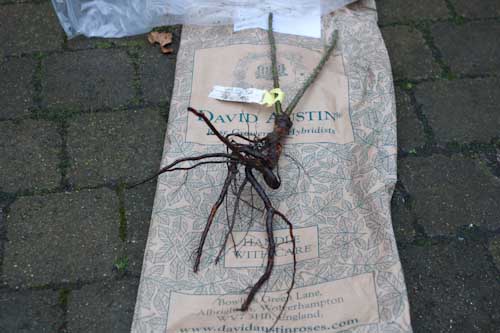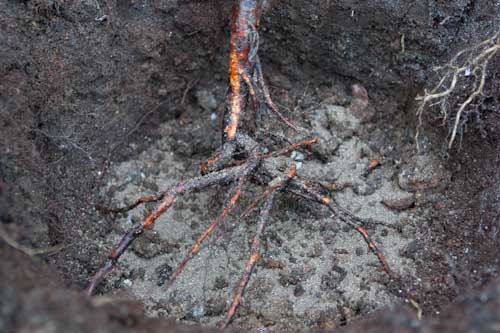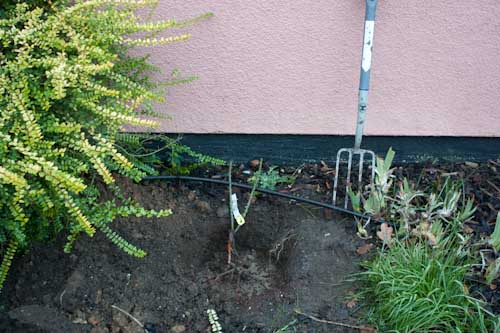Bare root roses are becoming increasingly popular. In this post we’ll discuss the benefits of bare root roses over potted varieties as well as proving some easy to follow instructions telling you how to plant them.
Below is the what a bare root rose looks like just after it arrived in the post.

Why Choose a Bare Root Rose?
Below are a few of the reasons I chose a bare root rose over a pot grown variety.
1. Variety. First of all by buying a bare root rose via the internet/post there is a much much bigger variety to choose from than if i went round my local nurseries. By buying a bare root online i was able to research all the varieties and order exactly the type I wanted.
2. Early Growth. Bare root roses are usually available in mid winter when the plants are dormant. By planting during this dormant period you allow the roots time to establish before the foliage growing season begins in the Spring. Consequently you get more first year growth from a bare root plant compared to a potted variety.
3. Cost. Because specialist growers can post bare root plants they can sell to a wider audience via mail order and the internet. As a result they can grow more plants, stock more varieties and sell each plant for less, all great news for the consumer.
How to Plant a Bare Root Rose
Pre soak. With bare root roses it is essential that the roots do not dry out prior to planting. As soon as you receive them soak the roots in a bucket of water, ideally over night
Location. First of all ensure that you’re planting your rose in an appropriate position. Some prefer more sun than other while some varieties are vulnerable top mildew so planting should be in the open to improve airflow.
Hole. Dig a nice big hole 12 to 18 inches deep and wide. If you planting against a wall ensure the hole is 6″ from the wall so as not to cramp the roots.
Soil Preparation. Roses are quite hungry feeders so make sure your soil is rich by adding well rotted compost. It is also a good idea to add a root growth powder (usually fungal based) like Mycorrhizal Fungi which add certain bacteria to the roots that promote vigorous growth. Apply such powders once the roots are in the hole allowing some of the powder to cover the roots as well as the surrounding soil, just like in the photo below.

Bare Root Rose Rooting Powder
Planting. Spread out the roots so they are flat to the bottom of the hole. This will provide the plant stability. The plant should be deep enough so that the bud union is just below the soil line. If planting against a wall it is a good idea to angle the stems slightly toward the wall to help training. Firm in the soil well.

Water and Mulch. Once planted be sure to water heavily, at least a couple of full watering cans. If the soil sinks with all the water then add some more. To help retain moisture around the plant build a small mound of mulch (compost or leaf mold) a couple of inches high.
After Care. Keep an eye on the weather and water if required. Keeping the roots moist really is crucial in the early growth stages until the roots are more established. You shouldn’t need to start feeding your rose until foliage starts to form in the Spring.
Varieties
You’ll soon realize there are hundreds of varieties to choose from when you start researching bare root roses. Be sure to take the time to research which rose is best for you. You’ll need to consider the following things when choosing a variety:
- Amount of sun exposure of site
- Growth space
- Colour
- Scent
- Flowering: Once v Repeating
- Disease resistance
- Flower shape
The variety I am planting in this post is a Gertude Jekyll climber from the highly recommended David Austin Roses. It is a repeating flowerer so should bloom all summer long with a good fragrance. It’s reasonably disease resistant and vigorous in growth. More importantly it provides bright pink flowers which is the only colour my wife will entertain!